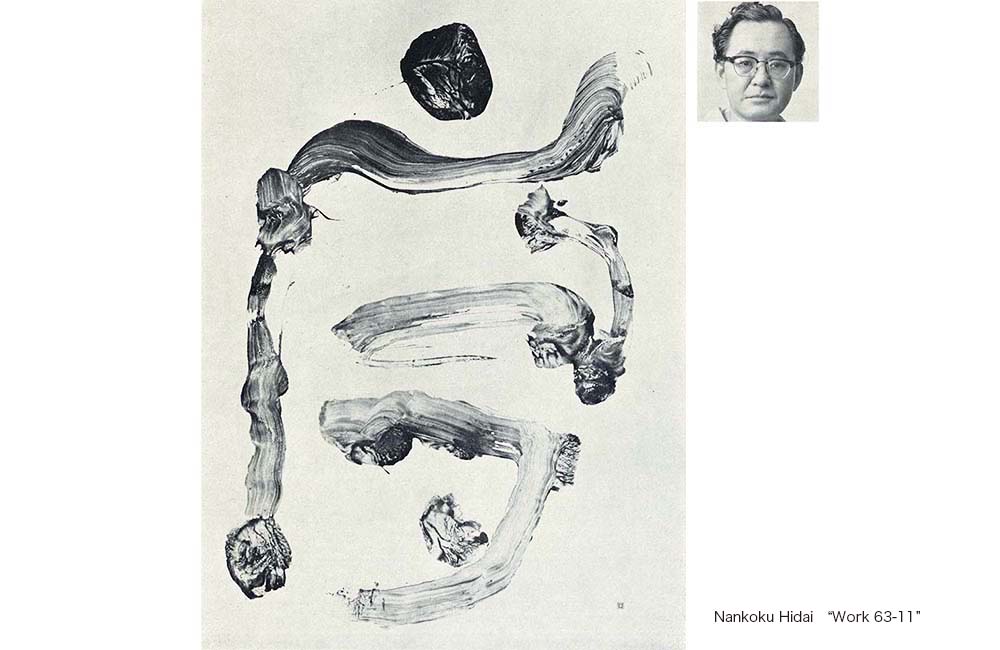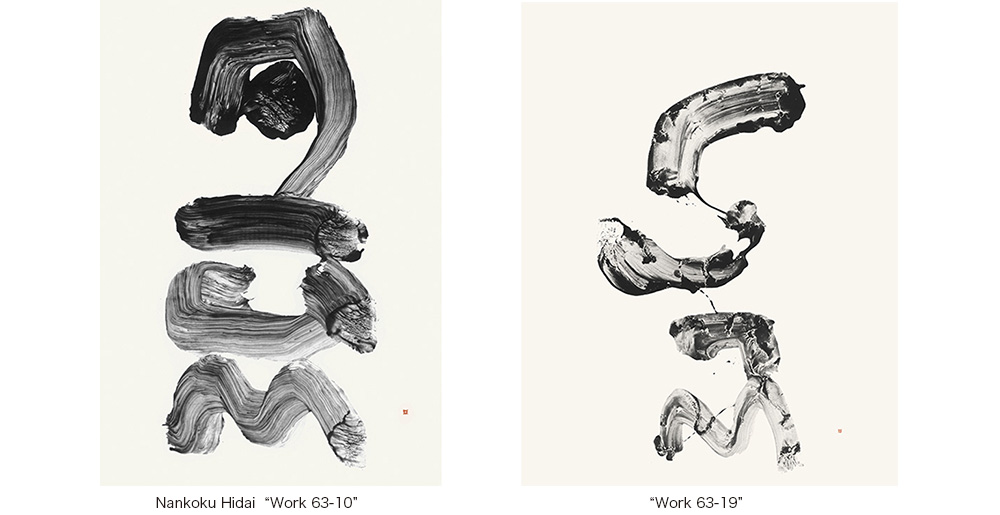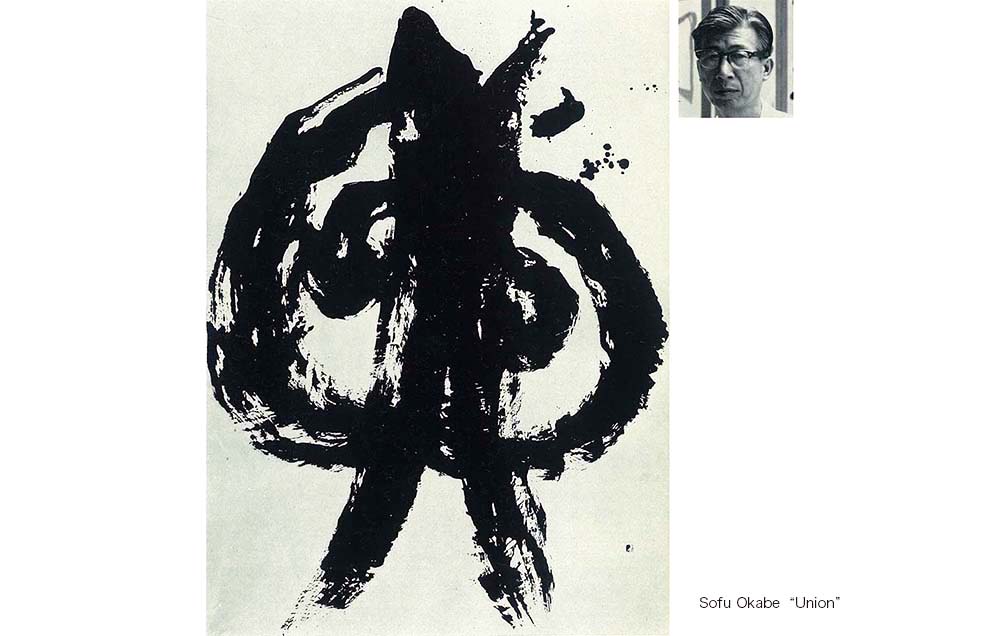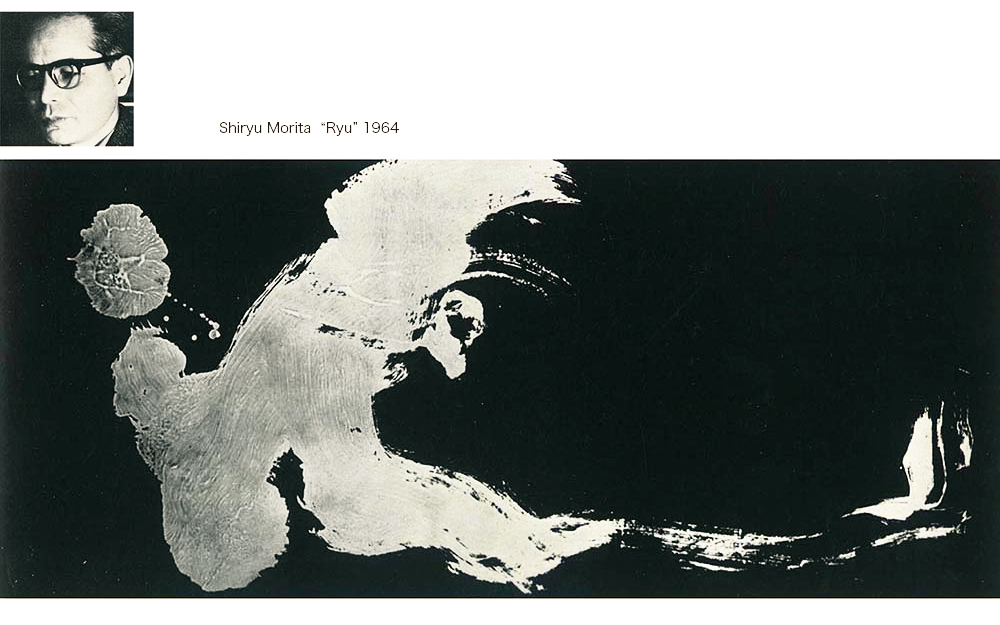On October 1, 1964, an exhibition of “Contemporary Japanese Painting " was held at the Corcoran Gallery of Art in Washington, a prestigious gallery of American museums. Since 1954, the Corcoran Gallery of Art has held biennial exhibitions of contemporary art from around the world. In the same way as the International Exhibition of Art by the Carnegie Museum of Art and by the Guggenheim Museum, the organizers themselves go around the world to select the exhibition works, not for just an overviewing introduction, but for an exhibition from a critical point of view. At this exhibition of contemporary Japanese art, Richard A. Madigan, assistant director of the Corcoran Gallery of Art, served as curator and visited Japan to select 18 artists and their works. As a painter, Jyosaku Maeda, Akira Hasegawa, Toshimitsu Imai, Hisashi Indo, Yukihisa Isobe, Takayasu Ito, Shin Kuno, Sadamasa Motonaga, Ko Nomura, Shu Takahashi, Soichiro Tomioka, Jiro Yoshihara (12 painters), and as a Japanese painting artist, Hidetaka Ohno, Ryonosuke Shimomura, Isao Mizutani (3 painters), and Nankoku Hidai, Sofu Okabe, Shiryu Morita as avant-garde calligrapher (*1).
Nankoku exhibited works such as "Work 63-10", "Work 63-11", "Work 63-19", Sofu Okabe “Union”, and Shiryu Morita "Ryu", etc.
The Corcoran Gallery of Art was a private museum of art founded in 1874, which was based on the collection of banker William Wilson Corcoran. It is known for its collections of American paintings from 1945, European paintings by Chardin and Picasso and others, and also contemporary paintings after 1945. Since 2014, the attached college has been transferred to George Washington University, where its collection is managed by the National Gallery of Art.
The New York Times published a commentary on the Exhibition of “Contemporary Japanese Painting” in 1964.




The New York Times, Monday, October 5, 1964
Art : 18 Abstractionists
‘Contemporary Japanese Painting’ at the Corcoran Gallery Is Impressive
By JOHN CANADAY (*2) Special to The New York Times
Washington, Oct 4
— “Contemporary Japanese Painting,” an exhibition at the Corcoran Gallery of Art, is probably as impressive a show of abstract art by 18 artists as could be assembled from a single country in the world today, an overboard comment that recognizes the dominant position of New York in the field as well as the 50-year-old tradition in France.
The strength of Japanese abstraction comes from a combination of forces individual to Japan---first, the spirit of revolt and experiment common to abstract art everywhere, and second a paradoxical Japanese return to home base with the realization that the Western revolt has been based on principles that are basic in ancient Japanese traditions.
Although Western abstract artists have been rather tiresomely insistent in pointing out that abstract art can find its antecedents in the best art of any age, they have had to strain the point. The Japanese artists—apparently to their recent surprise—have discovered that their efforts to emulate Western artists have only brought them back to a fuller recognition of their own esthetic tradition.
The most obvious instance is the vogue for calligraphic mannerisms. Jackson Pollock's looping and swirling skeins of paint have created a flourishing calligraphic emphasis in contemporary Western art, but what for Pollock and his descendants has been a device expressive of released energy has been for the Japanese, over centuries, a system of harmonizing a visual symbol with a philosophical thought.
A word-symbol (*3) in Japanese calligraphy, presented as a drawing, can become at once. something to read in the literal sense and an abstract expression of the significance of the word. When a contemporary Japanese artist like Sofu Okabe throws onto the paper a design representing the symbol for “Union,” he does so in a way that makes the resultant image, even for Western eyes, an abstraction of an idea based on forms (*4) usually inherent in the origin of the symbol. This makes him essentially a traditional rather than a contemporary artist.
The three calligraphers in the Corcoran show were selected to represent three aspects of this branch of Japanese art. Sofu Okabe, just mentioned, sticks closely to the conventional word-sign. Nankoku Hidai invents forms as freely as (for instance) the American Mark Tobey invents them when, ignorant of Japanese writing except as something visually beautiful, he lunges onto the paper with his brush. In between these limits, Shiryu Morita begins with conventional word signs and modifies them at will.
For a Westerner, this kind of Japanese painting loses half its meaning, since we can enjoy it only as a pattern and brushwork. We can never be certain, in our belief that the Japanese (and Chinese) are the great masters of this form of abstraction, just how much we are reading into their mastery from our knowledge that it is an expression of an inherited but uninterruptedly vital art form.
In Japanese abstract painting outside calligraphy there may also be a tendency for a Westerner to tie too closely to a belief in traditional expression when he finds Japanese abstract art more solid than its Eurasian (*5) half brother. But there can be no question, in the face of a show like the Corcoran's, of the superiority of Japanese craftsmanship.
Early Japanese art was concerned with the textures of odd bits of wood and stone as natural phenomena that could be appreciated by esthetic standards applicable to created objects, just as Western art has recently found the junkyard a mine for the materials of sculpture and college, or just as Marcel Duchamp find “readymades” in manufactured objects that are more or less transformed when mounted and displayed as art.
By this curious roundabout way the Japanese have rediscovered a birthright that combines the exquisite (but often sterile) workmanship of such crafts as lacquer with an older recognition of the beauty of natural shapes and textures. In combination, these two strains (*6) give Japanese abstract art a legitimacy invulnerable to the charge so easy to make against Western abstraction---that it is an easy way out, a mistaking (*7) of ends for means.
The Corcoran show was selected in Japan by Richard A. Madigan, the museum’s assistant director, and is intended largely to demonstrate this traditional-contemporary quality of Japanese art today rather than to summarize its multiple aspects. Sponsored by the Embassy of Japan and the Kokusai Bunka Shinkokai in Tokyo, the show has been given a first-rate installation.
As an incidental comment, visitors to Washington might be warned that some taxi drivers have no idea what or where the Corcoran is and can’t find it in their street directories — for the good reason that it isn’t in there. (Until recently the Corcoran has been dead enough to explain this.) You are likely to wind up at the National Gallary of Art (not a bad place) instead of the corner of 17th Street and New York Avenue, Northwest, which is where the Corcoran is.
And if there is anyone who does not know that the Phillips Collection (1600 21st Street) and the Freer Gallery (Jefferson Drive at 12th Street, Southwest) are two of the delights among American museums, then that person owes himself a trip to Washington before the Corcoran’s Japanese show closes on Nov. 29.
It will travel thereafter to the Des Moines Art Center, the M. H. de Young Memorial Museum in San Francisco, the Isaac Delgado Museum of Art (*8) in New Orleans, and the Detroit Institute of Arts.
The Corcoran is closed Mondays.
Note
(*1) Jyosaku Maeda (1926-2007) was pointed out by the critic Jalensky as a "mandala-like" style, during his stay in Paris from 1958 to 1966. After a trip to India in 1972 and a trip to Iran and Iraq in 1974, the study of this "mandala" iconography was further deepened, pursuing a cosmic image based on the iconography of the mandala as the basic principle of modeling.
Akira Hasegawa(1925-2005)presented works in which some of his works moved, works that were colored by attaching industrial waste materials to a flat surface, and objects that expressed the balance and beauty of the waste material itself.
Toshimitsu Imai(1928-2002 ) was based in Japan and Paris as an art informel painter. He knew Sam Francis and Michel Tapie, he himself participated in the art informel movement.
Hisashi Indo(1925-2009)took the direction of monochrome painting from 1956, and attracted a great attention at the Yomiuri Indépendant exhibition.
Yukihisa Isobe(1936-)connected abstraction in the 1950s with pop art in the 1960s. And he created reliefs that repeated emblem style and attracted attention. In 1965, he moved to New York to study environmental arts. He created many works with the Earth Art Festival.
Takayasu Ito(1934-1985)created the Infinite Space series, which filled the entire screen with plaster hemispheres. With the aim of de-painting without color and image from the screen, he worked on architectural design, environmental design, and video works, leaving his work in a multifaceted field.
Shin Kuno(1921-1998)established as unique styles from painting expressions using materials such as plaster, iron, lead, and cloth directly, to metals such as steel, relief-like abstract works using geometric forms combining straight lines and curves.
Sadamasa Motonaga (1922-2011)joined Gutai Art Association at the invitation of Jira Yoshihara. He aspired to create unprecedented picture books using abstract paintings in the early days of his activities. From that time until he left the association in 1971, Motonaga was a central member.
Ko Nomura(1927-1991)joined the Panreal Art Association. The Panreal Art Association was an avant-garde art group formed in 1949 with the aim of innovating Japanese painting. At first, he changed from surrealist figurative works to abstract expressions, and began presenting collage works in the late 1950s. In 1961, he exhibited his work on variously processed and pasted stamped stamps used for paper printing, etc. at the Panreal Exhibition.
Shu Takahashi(1930-)was selected for the first time at the 19th Independent Art Association Exhibition in 1951, and since then he has exhibited and won numerous exhibitions for the Independent Art Association, and in 1961 he was awarded the Yasui Prize for "Moon Road".
Soichiro Tomioka(1922-1994)developed his own white paints which was called "Tomioca White". In famous works such as "White World Series", he invented the white paint necessary for himself, and forged necessary tools, long painting knives. He developed techniques to create a "white world" of all states.
Jiro Yoshihara(1905-1972)formed Gutai Art Association. The Gutai exhibition attracted the attention of Michel Tapie, a French art critic who led Art Informel. He himself drew many works on the subject of a circle, such as drawing a large white circle on a black ground.
Hidetaka Ohno (1922-2002) joined the Panreal Art Association and published the Panreal Declaration in 1949 with Ryonosuke Shimomura and so on, but in 1946 he turned to traditional Japanese painting from abstract painting.
Ryonosuke Shimomura(1923-1998)participated in the formation of the Panreal Art Association in 1949. He developed an innovation movement in the postwar Japanese painting world and was known as "unyielding painter”. He shifted to a screen with sharp line drawings using architectural ink pots, and also he raised the paper clay on the screen to make it a relief shape, and created a tough style with a unique texture that expresses the shape of a bird like a fossil is completed.
Isao Mizutani(1922-2005)used pigments from Japanese paper and Japanese painting called "Lye 膠絵(にかわえ)", which has attracted attention both in Japan and abroad since around 1960. In addition to painting, he worked on a wide range of activities, including “Buto“ stage art by Tatsumi Hijikata and Kazuo Ohno.
Nankoku Hidai(1912-1999), Sofu Okabe(1910-2001), Shiryu Morita(1912-1998)
(*2) John Canady ( John Edwin Canady 1907 – 1985) was a leading American art critic, author and art historian. In 1959 Canady began a 17-year career as a leading art critic for The New York Times.
(*3) A word-symbol is a Chinese character.
(*4) Forms, namely ancient Chinese characters, for example, ancient Chinese characters inscribed on oracle bones and tortoise shells’ (亀獣骨文字) in the Yin (殷) or bronze-vessel and bell inscriptions (鐘鼎文).
(*5) Eurasia is the land mass formed by the continents of Europe and Asia, except Japan.
(*6) Two strains, that is to say, one strain is that Japanese art is concerned with the textures of wood and stone and recognizes the beauty of natural shapes and textures, and another strain is that the Japanese artists inherit exquisite workmanship of such crafts as lacquer from Japanese traditions.
(*7) A mistaking of ends for means is that the exquisite workmanship and the recognition of the beauty of natural shapes and textures are not ends but means, and Japanese artists insist that just on this ground Japanese abstract art is original and inherent in Japan, different from Western abstract art. That is a mistaking of ends for means.
(*8) Isaac Delgado Museum of Art is included in New Orleans Museum of Art (NOMA) at present.